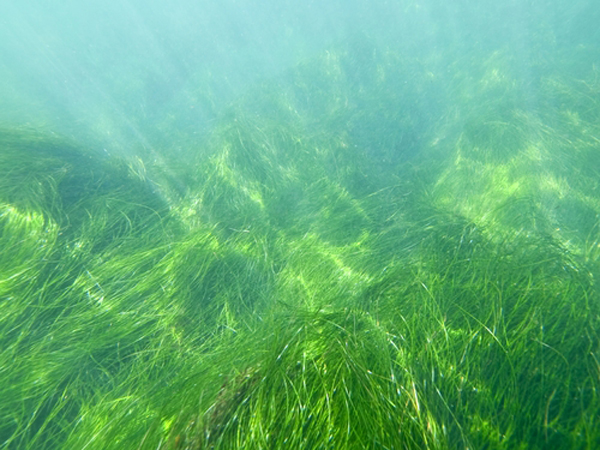Around the Water Cooler: Seagrasses are the nurseries of our coastal waters
By Lahne Mattas-Curry
 Do you like seafood? I love it. I live in Maryland, home of the best crabcakes in America. You know what helps make those crabcakes delicious? Seagrass.
Do you like seafood? I love it. I live in Maryland, home of the best crabcakes in America. You know what helps make those crabcakes delicious? Seagrass.
Well, maybe not directly, but seagrass provides shelter and a nursery area where many economically important (and tasty!) fish and shellfish start life.
Seagrasses also provide us with other important benefits such as stabilizing sediment along the shoreline and providing protection from storms and hurricanes. They are found primarily in shallow and sheltered waters on our coastlines.
But nutrient pollution, one of the most challenging environmental problems of our time, is smothering seagrass beds. When there are too many nutrients in our water – nitrogen and phosphorus to be specific – we get blooms of tiny marine organisms called phytoplankton in the water, reducing clarity. Algae growing on the seagrasses can also reduce the amount of light reaching seagrass leaves.
Where seagrasses are stressed by nutrient pollution, they can eventually disappear. Since so many people love to eat fish and crabs, the decrease in production of seafood will make it more expensive and harder to find. That’s a tough pill to swallow.
EPA marine ecologist Jim Hagy is using historical and recent maps of seagrass along the Florida coast to figure out how deep they once grew and how deep they are growing today. This will help us figure out how clear the water should be in order to protect this important aspect of our coastal ecosystems.
A map of seagrass depth colonization may not sound too exciting, but the research is important because it is the basis “to develop biological endpoints to support nutrient criteria in Florida estuaries,” says Hagy. “Florida estuaries will soon enter a new chapter in their history, one that we hope will include reliable protection for the State’s high quality waters and a credible path to restoration for impaired waters.”
And for the rest of us, healthy seagrasses will help ensure that we can still get a really good crabcake or seafood dinner!
About the Author: Lahne Mattas-Curry works with EPA’s Safe and Sustainable Water Resources team, drinks a lot of water and communicates water research to anyone who will listen.
Editor's Note: The opinions expressed in Greenversations are those of the author. They do not reflect EPA policy, endorsement, or action, and EPA does not verify the accuracy or science of the contents of the blog.

Help Us…. Those Are Pollutions !!!
Times are changes. The devil then and now do not satan again, but X. Confusing…., people or nature? A map of seagrass,for example, could be destroyed by both and should happen for the others. So, producers and people should begin the environmental movies, do not horror…..!
Great blog Lahne. For your readers, find out more about EPA diving scientists work on this topic at http://www.facebook.com/EPADivers along with some great shark photos among seagrasses by EPA diving scientists Phil Colarusso and Chuck Protzmann. Estuaries (and their seagrasses) are vital!
Great information Lahne, same problem as in British Channel between England and Brittany north of France.